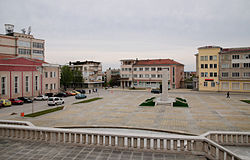Lyaskovets
|
Lyaskovets Лясковец |
||
|---|---|---|

Lyaskovets central square
|
||
|
||
| Location of Lyaskovets | ||
| Coordinates: 43°6′N 25°43′E / 43.100°N 25.717°ECoordinates: 43°6′N 25°43′E / 43.100°N 25.717°E | ||
| Country | Bulgaria | |
|
Province (Oblast) |
Veliko Tarnovo | |
| Government | ||
| • Mayor | D-r Ivelina Getsova | |
| Elevation | 192-256 m (−648 ft) | |
| Population (31.12.2009) | ||
| • City | 10,314 | |
| • Urban | 13,735 | |
| Time zone | EET (UTC+2) | |
| • Summer (DST) | EEST (UTC+3) | |
| Postal Code | 5140 | |
| Area code(s) | 0619 | |
Lyaskovets (Bulgarian: Лясковец) is a town in central northern Bulgaria, located in Veliko Tarnovo Province, 10 km northeast of Veliko Tarnovo, 2 km southeast of Gorna Oryahovitsa and 5 km south of the Yantra River, north of the Balkan Mountains. Its name comes from the word leska ('hazel') or leshnik ('hazelnut'), because the tree was abundant in the area. As of December 2009, the town has a population of 10,314 inhabitants.
Lyaskovets Peak, in the sub-Antarctic, is named after the town.
Near to the town is located the Monastery of Lyaskovets(Petropavlovski monastery).
The area around the town has been inhabited since the 4th millennium BC, but grew as an important Bulgarian settlement in the Middle Ages, during the Second Bulgarian Empire, because of its proximity to the capital fortress of Veliko Tarnovo. The SS Peter and Paul Monastery helped its development as a religious centre, and Lyaskovets took the form of five neighbourhoods named after their respective churches (for which the town is still famous): St Athanasius, St Basil, St George, St Demetrius and St Nicholas. These neighbourhoods were established at different time by settlers, and grew to merge as one.
After the Ottoman conquest of Bulgaria in the 14th century, Lyaskovets, together with the neighbouring villages of Gorna Oryahovitsa, Dolna Oryahovitsa and Arbanasi, was formally regarded as autonomous (i.e. not part of the rayah) according to a 1538 decree of Selim II. Though this was confirmed by later decrees, such as one by Mahmud II in 1810, Lyaskovets (Turkish: Leskofça) developed as a centre of revolutionary activity, and three armed uprisings set off from the monastery in the 18th and 19th century.
...
Wikipedia


